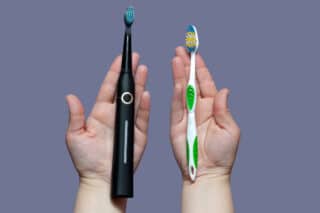
More Dental Health Articles
Your Guide To Choosing the Right Toothbrush

Patients often ask about the type of toothbrush they are using and if it is most effective for their individual mouths. It is important to find a toothbrush that is comfortable and works well to encourage the frequency of brushing for kids and adults alike.
Manual Toothbrushes
Your toothbrush should fit in your mouth comfortably and allow you to easily reach all of your teeth. The head should cover one to two teeth at a time. Larger heads may be difficult to maneuver inside of the mouth to reach difficult areas, especially for those with smaller mouths.
Adults should take over brushing for their child until they feel that their child can brush all surfaces effectively and for two minutes. Toothbrushes for children should have smaller heads, and larger handles to make it easier for their little hands to grasp. If your child is smaller or larger than their peers or has a delayed or advanced dental development, ask your dentist for the appropriate size toothbrush. A large handled toothbrush is also recommended for those individuals with limited dexterity.
Soft-bristled toothbrushes are good at removing plaque and debris to your teeth without causing a great deal of damage to the supporting tooth structures. Medium to hard bristles can cause a condition called recession where the gum tissue can become lowered away from the teeth exposing root surfaces. For increased protection bristles can be purchased with rounded tips.
Powered Toothbrushes
Powered toothbrushes are a great option for those who have limited manual dexterity. Those with braces or intraoral appliances may also benefit from a powered toothbrush. Powered toothbrushes often include a timer and help encourage longer brushing and make it fun for your child.
No matter what toothbrush you choose, make sure that you are brushing at a 45 degree angle in a circular motion for at least two minutes morning and night. Include flossing at least once a day. Your toothbrush should be replaced every three months, or when they show wear. Your toothbrush should also be changed after every illness to prevent reinfection.
Looking for the American Dental Association, seal of approval on your toothbrush can be a good start to picking the right toothbrush. If you have any question about the right toothbrush or brushing technique, be sure to ask your dentist at your next six month check up.
Other Articles You May Find of Interest...
- Let’s Smile Dental’s 7&Up Club
- Strengthening Smiles: Understanding the Importance of Splinting Periodontally Involved Teeth
- Understanding Soft Tissue Grafting: A Key To Periodontal Health
- New Solutions for Dentures and Dental Implants
- Benefits Of Immediate Dental Implants
- Preventing Tooth Injuries During Your Child’s Active Summer
- How New Tech In the Dental Office Benefits You

















